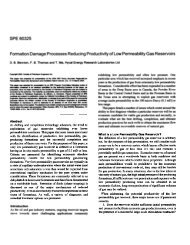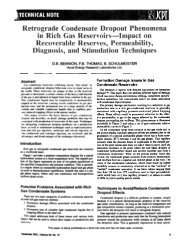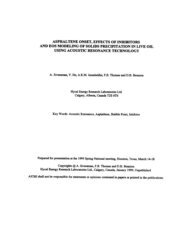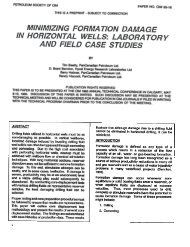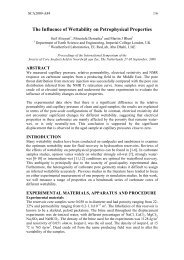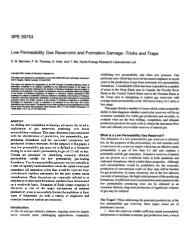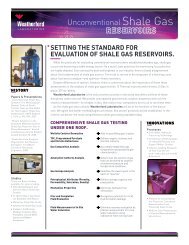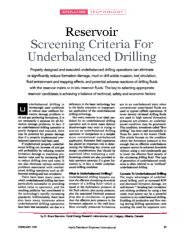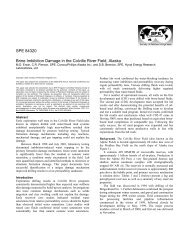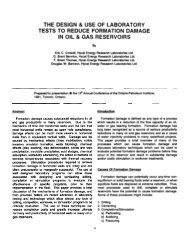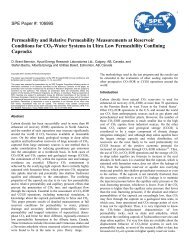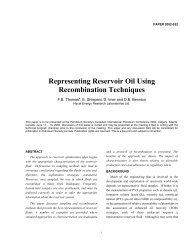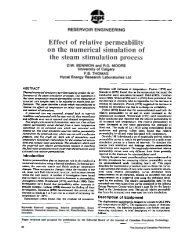The Nominal Sand Control Screen: A Critical Evaluation ... - OnePetro
The Nominal Sand Control Screen: A Critical Evaluation ... - OnePetro
The Nominal Sand Control Screen: A Critical Evaluation ... - OnePetro
Create successful ePaper yourself
Turn your PDF publications into a flip-book with our unique Google optimized e-Paper software.
SPE 56591 THE NOMINAL SAND CONTROL SCREEN: A CRITICAL EVALUATION OF SCREEN PERFORMANCE 3group of screens indicates that most have similar sandretention efficiencies, which the exception of one screen.<strong>Screen</strong> #6 appears to retain relatively more sand than the otherscreens in Group II.One of the main justifications for running performancetests on screens is brought forth by the evaluation of thescreens from screen manufacturer D. Manufacturer D initiallysupplied screens with only "small" and "large" openings.However the North Sea Business Unit also wanted a screenwith an opening somewhere in between the "small" and"large" opening screen. It should be noted that there werenumerical values associated with the name of each screenwhich implied the relative size of the openings in each screensample. It was "assumed" from the numbers associated witheach screen sample that the higher the number, the larger theaverage opening in the screen. Inspection of Figures 2 & 3shows that the screen with the "medium" openings plugs muchfaster than the screen with the "smaller" openings and lets lesssolids through than the screen with the "smaller" openings.When confronted with this information, Manufacturer Downed up to the fact that to make the screen with the"medium" openings, and the screen with the "larger" openingswas simple compressed, i.e., made thinner. This techniquemay have made a sample with an average opening "smaller"relative to the screen with the "larger" openings; however, it isspeculated that the process of compressing the screen with the"larger" openings resulted in much less open area, which inturn caused the screen with the "medium" openings to plugfaster than the screen with the "smaller" openings. <strong>The</strong> resultsof this analysis shows how important it is to run aperformance tests on screens rather than take the numericalvalue assigned to the screen by a service company as havingany relationship to the relative solids retention capability ofthe screen.<strong>Screen</strong> Efficiency Plot. In order to better understand therelationship between the pressure profiles and the gravimetricprofiles, a methodology was developed called a SE Plot (<strong>Screen</strong> Efficiency Plot ). <strong>The</strong> SE Plot shows the normalizedrelationship between the Performance Factor and the <strong>Sand</strong><strong>Control</strong> Factor. <strong>The</strong> Performance Factor and the <strong>Sand</strong> <strong>Control</strong>Factor are related to the pressure profile and gravimetricanalysis as follows:Where:Where:Performance Factor = T/ApT = time for the pressure profile to reach 100 psiAp = total area under the curve of the pressure profile<strong>Sand</strong> <strong>Control</strong> Factor = 1/ AgAg = total area under the gravimetric profile<strong>The</strong> SE Plot for the screens tested for the North Sea sandare shown in Figure 4.<strong>The</strong> objective of using the <strong>Screen</strong> Efficiency Plot (SE Plot)is to allow the practicing engineer to select a sand controlscreen based on the relative performance of all the screensunder consideration for a particular application. In practice,the SE Plot shows the relationship between the normalizedsand control characteristics (i.e., <strong>Sand</strong> <strong>Control</strong> Factor) of thescreens and the normalized length of time it takes a screen toplug under a certain set of conditions (i.e., the PerformanceFactor). <strong>The</strong> "perfect" sand control screen would have valuesof 1 & 1 for both the <strong>Sand</strong> <strong>Control</strong> and Performance Factors.Based on this criteria, the best screen is <strong>Screen</strong> #7. However,inspection of Figure 4 shows that both <strong>Screen</strong> #1 and <strong>Screen</strong>#8 give much better relative sand control than <strong>Screen</strong> #7 whilegiving up only a small amount of relative performance.<strong>The</strong>refore, just on the data from the SE Plot, <strong>Screen</strong> #1 and<strong>Screen</strong> #8 are ranked as good second choices.In many cases, there are other factors that also effect thechoice of the screen for an application. <strong>The</strong> obvious are costand availability. In the case for North Sea, there is otherinformation which caused careful consideration to using either<strong>Screen</strong> #1 or <strong>Screen</strong> #8. <strong>Screen</strong> #1 was initially used in theNorth Sea completions. However, the completions started tofail; i.e., started to make sand. Even though the cause is notknown, the recent failures of <strong>Screen</strong> #1 resulted in the choiceof <strong>Screen</strong> #7. <strong>Screen</strong> #8 was not chosen because of theinformation learned concerning the manufacturing processduring the analysis of the SE Plot data.Based on the SE Plot and additional information, Table 3shows the rankings of the screens tested for the North Seasand.



